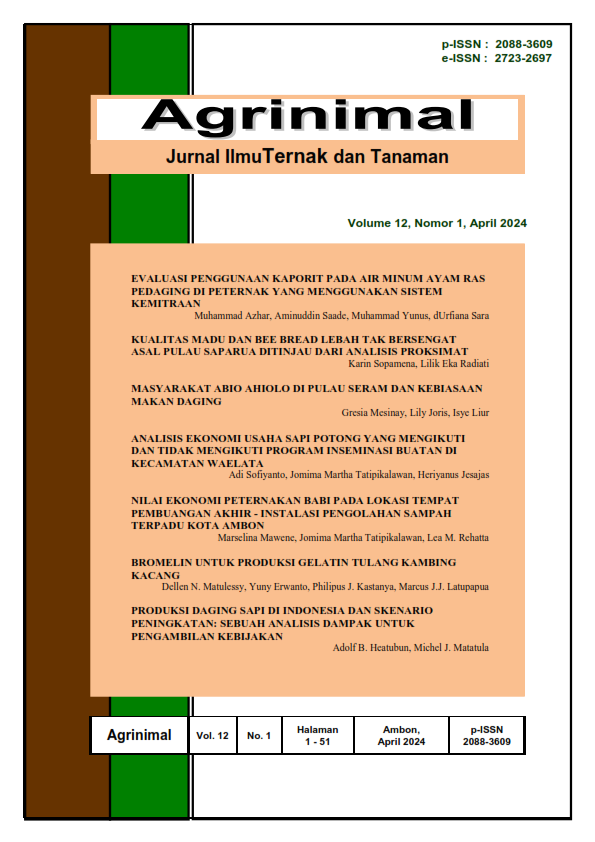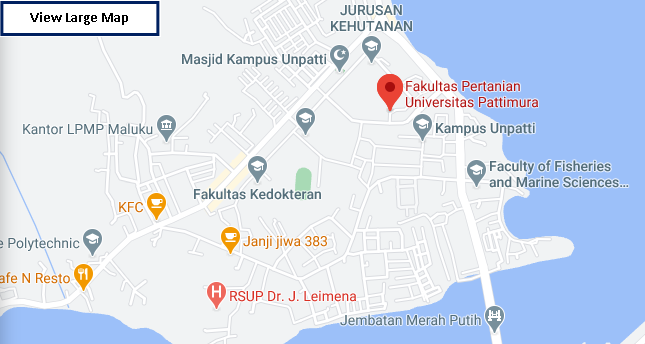MASYARAKAT ABIO AHIOLO DI PULAU SERAM DAN KEBIASAAN MAKAN DAGING
ABIO AHIOLO COMMUNITY ON SERAM ISLAND AND MEAT EATING HABITS
Abstract
Masyarakat Abio-Ahiolo merupakan keturunan suku Wemale, mendiami Desa Abio-Ahiollo di Kecamatan Elpaputih, Kabupaten Seram Barat. Guna memenuhi kebutuhan pangan sumber protein hewani, masyarakat Abio-Ahiolo lebih banyak mengkonsumsi daging hasil perburuan. Penelitian bertujuan untuk mengetahui jenis-jenis daging dikonsumsi sebagai sumber protein hewani, banyaknya dan frekwensi makan daging, serta cara pengolahan dan pengawetan daging masyarakat di Desa Abio-Ahiolo. Metode yang digunakan adalah metode survey, dimana wawancara dilakukan terhadap 30 responden yang dipilih secara acak. Hasil penelitian menunjukkan jenis daging yang dikonsumsi adalah daging sapi sebanyak 30 rumah tangga (100%), ayam kampung sebanyak 18 rumah tangga (60%), babi hutan sebanyak 29 rumah tangga (96,66%), rusa sebanyak 26 rumah tangga (86,66%), ular delapan rumah tangga (28,66%), burung maleo 30 rumah tangga (100%), burung kasawari 30 rumah tangga (100%), kuskus 29 rumah tangga (96,66%) dan anjing tiga rumah tangga (10%). Frekuensi makan daging babi hutan (2-4 kg), rusa (1-3 kg), ular (1-2 kg), burung maleo (1-2 kg), singkong (1-2 kg) dan kuskus ( 2 -4 kg). Terbentuknya kebiasaan konsumsi daging cenderung dilatarbelakangi oleh keyakinan atau keyakinan masyarakat dan hasil adaptasi masyarakat terhadap lingkungan untuk memenuhi kebutuhan protein hewani.
ABSTRACT
The Abio-Ahiolo people are descendants of the Wemale tribe, inhabiting Abio-Ahiollo Village in Elpaputih District, West Seram Regency. In order to meet their food needs for animal protein sources, the Abio-Ahiolo people consume more meat from hunting. The research aims to determine the types of meat consumed as a source of animal protein, the amount and frequency of eating meat, as well as how people process and preserve meat in Abio-Ahiolo Village. The method used is a survey method, where interviews were conducted with 30 randomly selected respondents. The results showed that the types of meat consumed were beef in 30 households (100%), free-range chicken in 18 households (60%), wild boar in 29 households (96.66%), deer in 26 households (86 .66%), snakes eight households (28.66%), maleo birds 30 households (100%), kasawari birds 30 households (100%), cuscus 29 households (96.66%) and dogs three households stairs (10%). Frequency of eating wild boar (2-4 kg), deer (1-3 kg), snake (1-2 kg), maleo (1-2 kg), cassava (1-2 kg) and couscous (2-4 kg) kg). The formation of meat consumption habits tends to be motivated by people's beliefs or convictions and the result of people's adaptation to the environment to meet their needs for animal protein.
Downloads
References
Arthatiani, F. Y., Kusnadi, N., & Harianto, H. (2018). Analisis Pola Konsumsi Dan Model Permintaan Ikan Menurut Karakteristik Rumah Tangga Di Indonesia. Jurnal Sosial Ekonomi Kelautan dan Perikanan, 13(1), 73-86.
[BPS] Badan Pusat Statistik Kabupaten Seram Bagian Barat. (2019). Kabupaten Seram Bagian Barat Dalam Angka Tahun 2019. Piru: BPS Kabupaten Seram Bagian Barat
Bernaddeta W. I R., Djonly Woran., Sientje Lumatauw & Rein E Kaikatui. (2022). Activities and Utilization of Game Animals in Yembikeri Village, Rumberpon District, Teluk Wondama Regency. Journal of Tropical Animal and Veterinary Science, 12 (1), 75-80.
Brand, T. S., Van Der Merwe, D. A., Hoffman, L. C., & Geldenhuys, G. (2018). The effect of dietary energy content on quality characteristics of Boer goat meat. Meat Science, 139, 74-81.
Ciputra. (2018). Hunting Strategy And Management Strategy. https://Www.Ac.Id.Library. [28/02/2023].
Frans, L. (2022). The Tradition of the Marind Kaliki Tribe Burns First. Hunting Later. https://jubi,co.id.amp. [28/02/2023].
Gomez, I., Janardhanan, R., Francisco, C. I., & Beriain, M. J. 2020. The Effects of Processing and Preservation Technologies on Meat Quality: Sensory and Nutritional Aspects. Foods, 9(10), 1416.
Hasyim A. (2022). Sop Iga Sapi, Cita Rasa Nusantara Yang Menggoda Selera. https://seilera.com/blog/ author/acim. [29/02/2023].
Kakatui, R. E. (2020). Tingkat Keberhasilan dan Nilai Ekonomi Kegiatan Berburu Rusa Timor (Cervus timorensis) dikampung Yembekiri Kabupaten Teluk Wondama. Skripsi. Manokwari: Universitas Papua.
Mayi, E. P., Kale, P. R., & Sipahelut, G. M. (2019). Pengaruh pemberian ekstrak buah jeruk purut (citrus hystrix) dan lama pengasapan terhadap sifatorganoleptik, kandungan protein dan lemak daging se’i babi. Jurnal Peternakan Lahan Kering, 1(1), 67-74.
Nurti, Y. (2017). Kajian makanan dalam perspektif antropologi. Jurnal Antropologi: isu-isu sosial budaya, 19(1), 1-10.
Pattiselanno, F., Seseray, D. Y., & Yohanes, C. H. (2016). Exotic menus from the forest: Encouraging food security for people in remote areas of Papua. Paper of the International Conference on Biodiversity, Eco-Tourism & Creative Economy. Jayapura (Indonesia).
Pelupessy, P. J. (2011). Esuriun Bati people. https://repository.uksw.edu. [29/04/2023].
Salakory, M. (2022). Maluku Dominan Pulau Pulau Kecil, Permasalahannya, dan Solusi Peran Lulusan Geografer Universitas Pattimura. GEOFORUM Jurnal Geografi dan Pendidikan Feografi, 1(1), 1-18.
Saragih, B. (2020). Agribisnis Berbasis Peternakan; Kumpulan Pemikiran. Bandung: Usese IPB.
Scaglioni, S., De Cosmi, V., Ciappolino, V., Parazzini, F., Brambilla, P., & Agostoni, C. (2018). Factors Influencing Children’s Eating Behaviours. Nutrients, 10(6), 706.
Seseray, D. Y., & Sumpe, I. (2017). Identifikasi Metode Pengolahan Daging Hasil Buruan secara Tradisional pada Masyarakat Masyarakat Kebar: patSebagai Upaya Penganekaragaman Sumber Protein Hewani. Prosiding Seminar Nasional Teknologi Peternakan dan Veteriner. Manokwari, Indonesia. pp. 686-692.
Rao, M., & McGowan, P. J. K. (2012). Wild Meat Use, food security, livelihoods, and conseration. Journal of Conservation Biology. 16(3), 580-583.
Sahusilawane, A. M. (2012). Inisisasi Orang-orang Huaulu di Pulau Seram. Edisi 1. Ambon: Balai Pustaka Unesco.
Monterossa, E. C., Frongillo, E. A., & Vandevijvere, S. (2020). Sociocultural Influences on Food Choices and Implications for Sustainable Healthy Diets. Food and Nutrion Bulletin, 41(2), 59-73.
Wijaya, Y. G. (2020). Knocking Sei, How to Make NTT Typical Smoked Meat": https://www.kompas.com/food/read/2020/07/06/204837575/mengulik-sei-cara-bikin-daging asap-khas-ntt?page=all. [06/05/2023].
Wilkiel, D. S., Michelle, W., Hubert, B., Sebastien, L., Nathalie, V., Daniel, C., Vincent, B. W., Robert, N, & Julia, E. F. (2016). Eating and conserving bushmeat in Africa. African Journal of Ecology, 54(2), 402-414.








